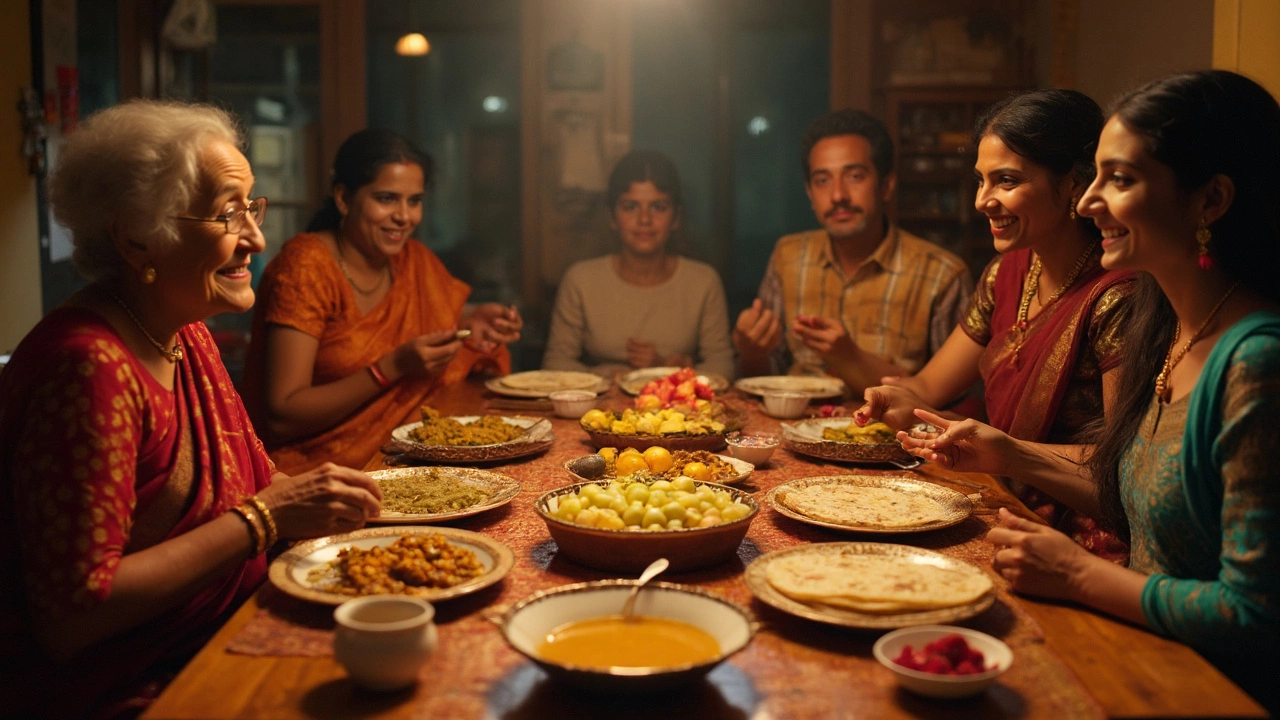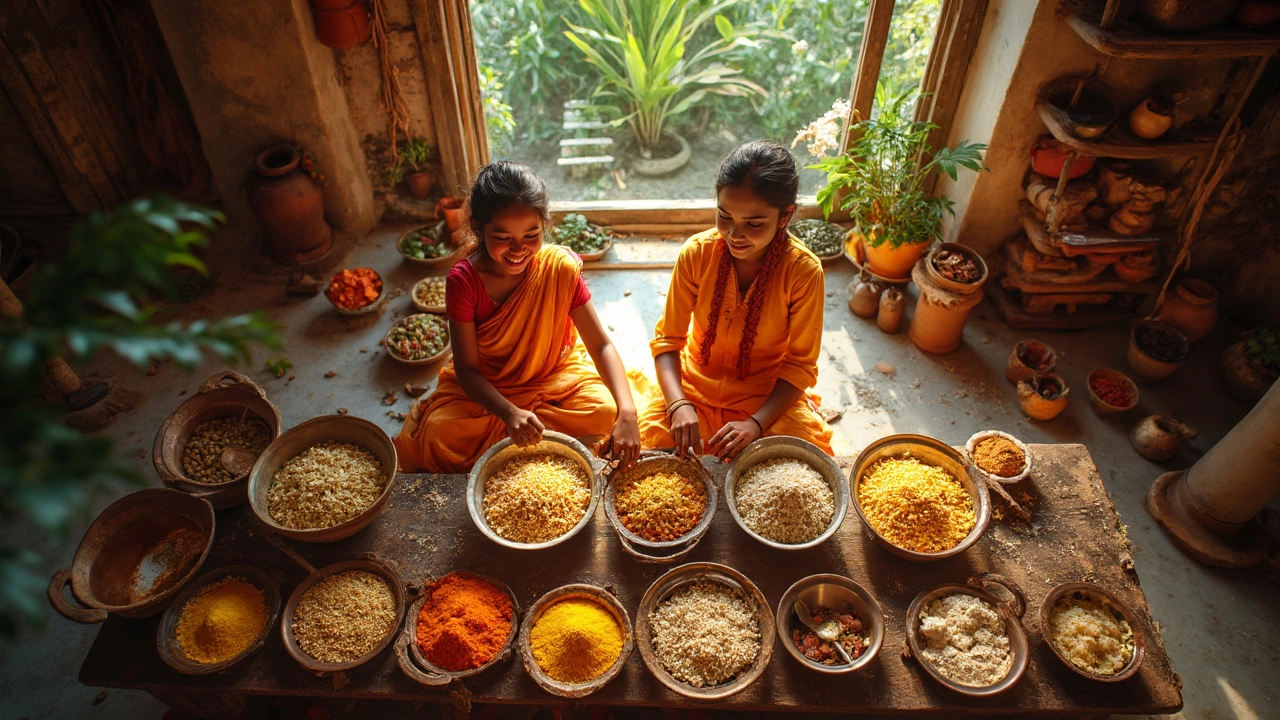Think India and you might picture spicy curries or colorful sweets, but everyday food here is a whole different story. Walk into any household and you’ll probably spot the same basics—rice and roti. These are the true heart of most meals, eaten with all sorts of veggies, lentils, or sides.
Rice isn’t just a dish, it’s the main event in places like West Bengal, Kerala, and pretty much the entire South. People can cook it plain, steam it, or turn it into quick comfort foods like lemon rice or curd rice. Even the leftovers get a makeover: fried rice, spiced rice, you name it.
On the other hand, roti is king up North. Soft wheat flatbreads get made in minutes and are easy to pair with almost anything. Plus, you don’t need any fancy stuff to make them—just flour, water, and a rolling pin. No tandoor? No drama. They cook up fine on a simple pan.
If you’ve ever wondered what’s really feeding over a billion people in India, it’s not just those flashy curries. It’s these humble carbs, made fresh every day. And guess what? They’re easier to cook than you think—even for total beginners.
- The Big Players: What’s Really on Every Plate?
- Rice vs. Roti: North, South, East, West
- How Traditions and Seasons Shape the Menu
- Easy Everyday Recipes Anyone Can Try
The Big Players: What’s Really on Every Plate?
When people ask about the most consumed food in India, it comes down to basics you can spot in almost every kitchen—rice and roti. These aren’t just popular, they’re absolutely everywhere, cutting across states, income levels, and even individual food choices. Statistically, over 60% of India’s population eats rice daily, and wheat-based rotis aren’t far behind, especially in northern states.
Let’s break down why rice and roti get this much love:
- Rice: India grows the most rice after China. It’s cheap, fills you up, and is super fast to cook. Each region has its own way of eating it—steamed plain, tossed with spices, or mixed with yogurt and veggies. Plus, you’ll spot fancy types like Basmati up North and short-grain varieties down South.
- Roti: Made with wheat flour, you’ll usually find it on plates across the north, west, and central parts of India. Fresh rotis puffed up on the pan are perfect for scooping up daal or sabzi. And guess what? It’s almost always made fresh, meal by meal.
| Staple Food | Regions Where It’s Main | Cooking Time | Typical Uses |
|---|---|---|---|
| Rice | South, East, North-East | 20-25 min | Served with curries, made into pulao, lemon rice |
| Roti | North, West, Central | 10-15 min | With veg or non-veg dishes, used for wraps |
Lentils—or ‘dal’—come a close third. Almost every meal has some version of it. It’s cheap, easy to cook, and a solid source of protein. There are dozens of types, from yellow moong to spicy masoor. The best thing is, you don’t need fancy skills to put together a basic dal or chana (chickpea) curry.
Bread gets a mention too. Besides rotis, people eat parathas, naan, or bhakri, depending on the state and occasion. And when there’s no time, instant rice or pre-made rotis from the freezer make life easier.
Honestly, if you ask ten people what they had for lunch, chances are, at least eight will say rice, roti, or both. That’s how central these foods are—simple, filling, and always on the table.
Rice vs. Roti: North, South, East, West
If you ask what the most consumed food in India is, it really depends on where you’re standing, because habits shift a lot from region to region. In the north, you’ll see people roll out stacks of roti every day. In the south and the east, rice rules the table. But why this split? It’s mostly down to what grows best in each part of India.
Northern states like Punjab, Haryana, Uttar Pradesh, and Rajasthan grow loads of wheat, so it’s natural that roti, chapati, and paratha are everywhere. Stuff them, roast them, keep them plain—rotis are the ultimate sidekick for curries, dals, or even pickles when there’s nothing else around. While you can spot rice here too, it’s not the main player except maybe during parties or fancy occasions.
Head south and everything flips. Think Tamil Nadu, Andhra Pradesh, Karnataka, and Kerala. Rice isn't just a food—it's a way of life. People eat it for breakfast, lunch, and dinner. Meals are built around it, with sambar, rasam, or coconut-based curries on the side. In fact, South Indians eat almost three times more rice per person than the average North Indian. Even breakfast is rice-based: idli, dosa, pongal—they all come from this cheap, filling grain.
Moving to the east (hello, Bengal, Odisha, Assam), rice is key again. It loves the rain, and these states get plenty. In Kolkata or Guwahati, it’s not about rotis—rice and fish curry is the classic. No celebration is complete without a mountain of steamed rice and an array of spicy or sweet sides. But don’t expect the same in Gujarat or Maharashtra, where people eat both but lean toward wheat as you move inland.
It’s all about climate and tradition. Where rice paddies flood the landscape, rice shows up in every meal. Where wheat grows tall, you’ll smell fresh rotis on every street. Here’s a quick glance at how this split looks in numbers:
| Region | Main Staple | Per Person Consumption (Yearly Estimate) |
|---|---|---|
| North India | Wheat (Roti, Chapati) | Up to 70 kg wheat |
| South India | Rice | 80-100 kg rice |
| East India | Rice | 90-110 kg rice |
| West India | Split (Rice & Wheat) | Varies widely |
If you’re trying to cook easy Indian recipes at home, this split matters. Pick a main carb that matches the region of the dish—think rotis with Punjabi dal, rice with Kerala stew, or both with a light Gujarati thali. This small change makes a big difference to how authentic the food feels—and tastes.

How Traditions and Seasons Shape the Menu
If there’s one thing constant about food in India, it’s change. What ends up on the table isn’t just about taste—traditions, festivals, family habits, and even the weather play a big part. For example, during summer, people in the South swear by curd rice. It’s cool, easy to prep, and helps beat the heat. In winter, families up North turn to hot rotis, parathas, and ghee-rich dishes that keep you warm and full.
Festivals are a whole different game. During the harvest festival of Pongal in Tamil Nadu, a rice dish called ‘pongal’ shows up in every home. Up North during Diwali, puris take center stage, paired with potato curry or even sweets. Then there’s Ramadan, when haleem (a wheat and meat porridge) and rich biryanis become nightly staples in Hyderabad. It’s all about celebrating with Indian staples that fit the occasion.
What you see in stores or markets also changes with the season. In the monsoon, there’s a sudden spike in steaming hot pakoras (fritters) and chai—comfort food for rainy days. Summertime pushes cucumbers, watermelons, and yogurt into daily meals across regions, while winter brings out root veggies and fresh greens.
| Region | Popular Seasonal Staples |
|---|---|
| South India | Curd rice (summer), Hyderabadi biryani (Ramadan), Pongal (harvest festival) |
| North India | Parathas (winter), puris (Diwali), sarson da saag with makki di roti (winter) |
| West India | Dhokla (monsoon), aamras (mango season), shira (festivals) |
| East India | Steamed rice (daily), pitha (festivals), fish curries (monsoon) |
What’s really interesting is how family recipes get handed down and adjusted over the years. Ask two families how they cook dal or mix their spice blends, and you’ll get wildly different answers. So when it comes to easy Indian recipes, don’t stress—there really is no single "right way." Just follow the seasons and your cravings, and you’ll end up with the most consumed food in India, your style.
Easy Everyday Recipes Anyone Can Try
If you’re looking to make real Indian staples at home, you don’t need any wild ingredients or special equipment. Here are quick recipes for the most consumed foods in India—rice and roti—that anyone can whip up without breaking a sweat.
How to Make Fluffy Rice (Basic Stovetop Method)
- Measure 1 cup regular rice. Rinse it a few times under cold water until the water’s clear. This gets rid of excess starch and keeps the rice from turning mushy.
- Add 2 cups of water and a pinch of salt in a saucepan. Drop in the rinsed rice.
- Bring the whole thing to a boil, then turn the heat low and cover the pan.
- Cook for 12–15 minutes, then switch off the heat. Let it rest for 5 minutes. Fluff it gently with a fork. That’s it—no magic needed!
For a twist, add a spoonful of ghee or a handful of frozen peas while cooking.
Classic Roti (Indian Flatbread) Recipe
- Mix 1 cup whole wheat flour with a pinch of salt in a bowl. Add water slowly, kneading until it turns into a soft, non-sticky dough.
- Roll the dough into 6–8 balls. Dust each ball with flour and roll into a thin circle (about 6 inches wide) with a rolling pin.
- Heat a pan on medium. Cook each roti for about 30–40 seconds per side, pressing gently with a kitchen cloth or spatula for puffiness. Watch out—they cook fast!
- If you like them softer, add a little ghee or butter right after they come off the pan.
Here’s a cool fact: According to a 2023 survey by the National Sample Survey Office, around 60% of Indian households make roti at least once a day, while over 70% cook rice just as regularly. Convenience and taste win every time.
| Staple | Avg. Daily Eaters (in millions) | Main Regions |
|---|---|---|
| Rice | 800 | South, East, North-East |
| Roti | 700 | North, West, Central |
If you’re short on time, don’t stress. Skip the fancy stuff and just serve these Indian staples with any dal, curry, or pickle you have handy. That’s how most families do it. Simple flavors, simple steps—no fuss cooking that still tastes like home.
